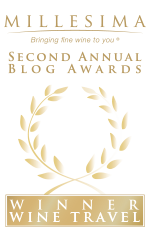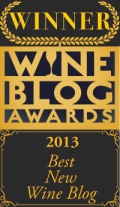While in Umbria, I stayed at the adorable B&B la Corte de’Vasari, set in a medieval building in Bevagna. On a side note, the B&B doesn’t really serve breakfast unless you prefer to start your day with a slice of cake and a side of cookie. Aside from that, the owner was charming and spent over an hour with me the night of my arrival, practicing English and helping shape my list of places to taste Sagrantino. Daniele, the proprietor, felt strongly about including Milziade Antano as a good example of a “humble and traditional” winery.
After my visit with Caprai, I followed Marco in my Jr. vehicle up to Antano. The winery had a gorgeous setting perched on a hilltop with views of the Apennine Mountains and Montefalco. I was meeting with Francesco, the owner/winemaker, who didn’t speak English, and his son Giordano, who did.
I could see why the innkeeper suggested Antano as a contrast; the operation was clearly a “garage” winery, particularly as compared to Caprai. Although the son spoke English and was knowledgeable about the specific wines, I had a little trouble getting background info on the winery and vineyard. I took to the web and found T. Edward Wines in NYC who import and distribute Antano. Their website noted the vines were planted in 1975, and that Antano is “old school” in style with a lack of intervention in the winery, no barrique and no high-tech equipment. In the vineyard, Antano green harvests aggressively and has very low tonnage per acre.
Inside the winery, the son Giordano poured each of the wines. I asked him if he planned to follow his lineage and make the wine at Antano. He crinkled his nose, looking at his dad out of the corner of his eye. He said he wasn’t convinced sticking around Montefalco was his destiny, but maybe time in a big(ger) city would bring him back one day, far away. Fair enough, I thought. I don’t think his Dad loved the response, translated for him by Marco, but it probably wasn’t the first time he had heard it.
After the father/son politics concluded, we addressed the wines. Milziade Antano has a line-up similar to most of the wineries in the area. They offer a Bianco IGT blend (but no 100% Grechetto); two Montefalco Rossos, one being a Riserva; two Sagrantinos, one version a vineyard designate “Colleallodole”; and a Passito.
Antano definitely excelled in their dry reds, which makes sense. The Montefalco Rossos were particularly lovely, both offering a wild streak of Sagrantino tamed by the softer Sangiovese and small percentage of Merlot. Sweet plums and black cherry were prevalent in the Rosso; the Riserva, which had a little Cabernet Sauvignon and more barrel time, showed additional notes of figs, blackberry and balsamic. The tannins in both were grippy; clearly the wines needed more time. I would’ve liked a nibble between tastes, but given the garage-style digs, I guess that was expecting too much.
The Sagrantinos were big, broad, palate ball-busters. They were demanding wines with an edge of rusticity, but yet attractive; infants in a bottle with a future you could envision. The 2008 was aged 3 years before release: 15 months in barrel, 15 months stainless steel and 6 months in bottle. The wine showed notes of coffee, tobacco, leather, cherry and blackberry with layers of spice.
The Colleallodole, made from a designated vineyard and only 1000 bottles produced, had similar notes, but an earthier quality, with accentuated tobacco, leather and raisin. The tannins were big but smoother. It was also double the price: $25 v. $50. Again, these are food wines and really need to sleep a half-decade before opening, but should be worth the wait.
Next up: The final stop on my winery tour, Adanti…





























